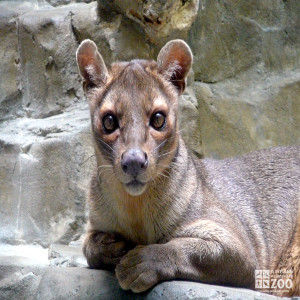Fossa
[Cryptoprocta ferox]

The fossa is Madagascar's largest terrestrial predator. It resembles the South American jaguarundi, a slender and lithe cat-like animal. The body is slender, but the limbs are very muscular. The head is similar to that of a mongoose but with a broader muzzle. The eyes are a medium brown with pupils that contract to vertical slits. Its retractable claws, typical feline short-jawed head, frontal eyes and round ears make it look like a cat. The tail is cylindrical. Also, the anatomy of its sex-organs resemble those of cats. However, fossas walk on the soles of their feet (Plantigrade) rather than on their toes (Digitigrade) like cats. Due to its general appearance, it was originally classed as a felid. Its resemblance to cats, however, is a result of convergent evolution. It is classified as but different from all other viverrids (cat-like animal). It has been described as having the appearance of a cougar, although considerably smaller. Head and body length is about 27.5 inches, and tail length about 25.5 inches. Adult weight can vary from 21 to 44 pounds. The coat is reddish brown to dark brown. The carnassial teeth, otherwise known as the large teeth of carnivores for cutting, rather than tearing, are well developed and upper molars reduced. The claws are retractile and the feet webbed. The ankles are 'reversible,' enabling the animal to grasp both sides of a slender tree trunk with the hind feet and descend head first or jump to an adjacent tree. Females show genital mimicry of males.
Location: Primate & Cat
Share:
Range
The range of the fossa is Madagascar.
Habitat
Fossas inhabit evergreen forests.
Conservation Status
VulnerablePrimary Threats
Human Wildlife CoexistenceGestation
Gestation takes 6 to 7 weeks.
Litter
Litter size is 2 to 4, and occasionally 6.
Behavior
The fossa evolved on Madagascar to fill the niche of a medium-sized nocturnal, arboreal predator and is an ecological equivalent of the Clouded leopard of Southeast Asia. The teeth and claws are adapted to a diet of animals that are captured with the forelimbs and killed with a well-aimed bite. They prefer to live in dens or holes. Their anal glands secrete a very unpleasant odor. The fossa lives at low populations densities and requires undisturbed forests, which are rapidly disappearing. They are solitary outside of the breeding season.
Reproduction
Fossas are seasonal breeders, mating between September and December. After a six to seven week gestation they give birth to two to four young in a tree or ground den. The newborn are quite small – 2.8 to 3.5 ounces. Physical development is slow; the eyes do not open for 16 to 25 days and solid food is not taken for three months. The mother raises the young alone. They are weaned by four months and growth is complete at two years. Sexual maturity is reached at 3 to 4 years.
Wild Diet
Insects, frogs, reptiles and mammals, including lemurs.
Zoo Diet
Dallas Crown Canine Diet, rabbits
